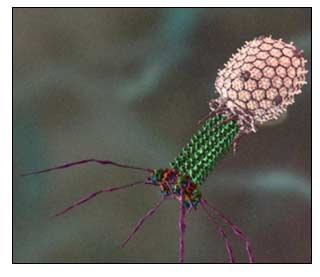ARLINGTON, Va., Aug. 20 -- Using a combination of imaging techniques, researchers have determined the mechanics that allow some viruses to invade cells by piercing their outer membranes and digesting their cell walls. The researchers combined their findings with earlier studies to create a near-complete scenario for that form of viral assault.
The results have a dual benefit: They show the inner workings of complex, viral nanomachines infecting cells (in a process nearly identical to some viral infections of human cells), and the images provide design tips for engineers hoping to build the gene delivery devices of the future.

The bacteriophage T4 is preparing to infect its host cell. The structure of bacteriophage T4 is derived from 3-D cryo-electron microscopy reconstructions of the baseplate, tail sheath and head capsid and from crystallographic analyses of various phage components. The baseplate and tail proteins are shown in distinct colors. (Photo: Purdue University and Seyet LLC)
The study, by researchers from Purdue University and the Shemyakin-Ovchinnikov Institute of Bioorganic Chemistry in Moscow, appears in the August 20, 2004, issue of Cell.
Led by Michael Rossmann and Vadim Mesyanzhinov, the team added their findings to several decades of research into the structure of bacteriophage T4 -- a virus that attacks the familiar pathogen Escherichia coli (E. coli). The work was supported by grants from the National Science Foundation, The Human Frontier Science Program and the Howard Hughes Medical Institute.
"The work opens up the door to further application of 'hybrid' techniques such as we used by combining crystallography and electron microscopy," said Rossmann, professor of biological sciences at Purdue University. "The results give hope that viruses might be targeted to find specific cells where they would then inject the cell with a genome that included useful new genes for the targeted cell."
The researchers combined x-ray crystallographic data, which gives 3-D atomic details of the constituent viral proteins, with cryo-electron microscopy images to determine how proteins in the T4 phage rearrange themselves during cell infection. Cryo-electron microscopy is similar to standard electron microscopy, except the specimens are first frozen to slow down radiation damage and hence improve the clarity of the images.
By combining thousands of images of the virus viewed from different directions, the researchers were able to determine a 3-D structure at about 17 Angstrom resolution, a distance spanned by just a few atoms. The end result is a model of how bacteriophage T4 infects cells.
Although some strains of E. coli can cause food poisoning, other strains supply essential products to the human gut. It is possible that studies of viruses could one day help biologists develop strategies to fight deadly bacterial infections. Similar efforts targeting antibiotic-resistant bacteria are already underway in other laboratories.
Now that the researchers have established relationships between the component proteins, they will be analyzing the conformational changes that occur during infection. As part of their continuing work, they are also looking at similar processes in other viruses to determine common essential features and differences related to the specific adaptation of each virus type.
For more information, visit: bilbo.bio.purdue.edu/~viruswww/Rossmann_home/index.shtml